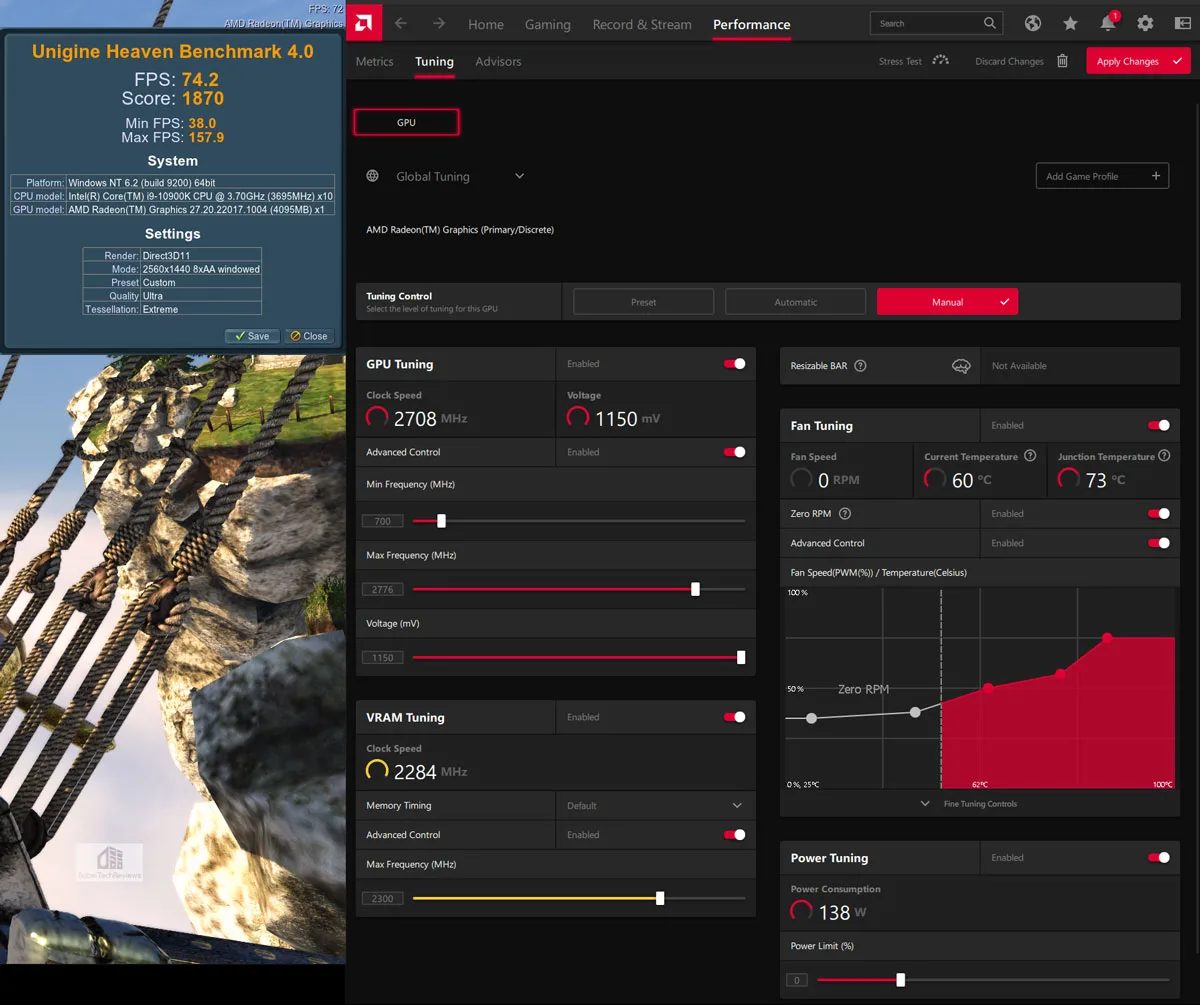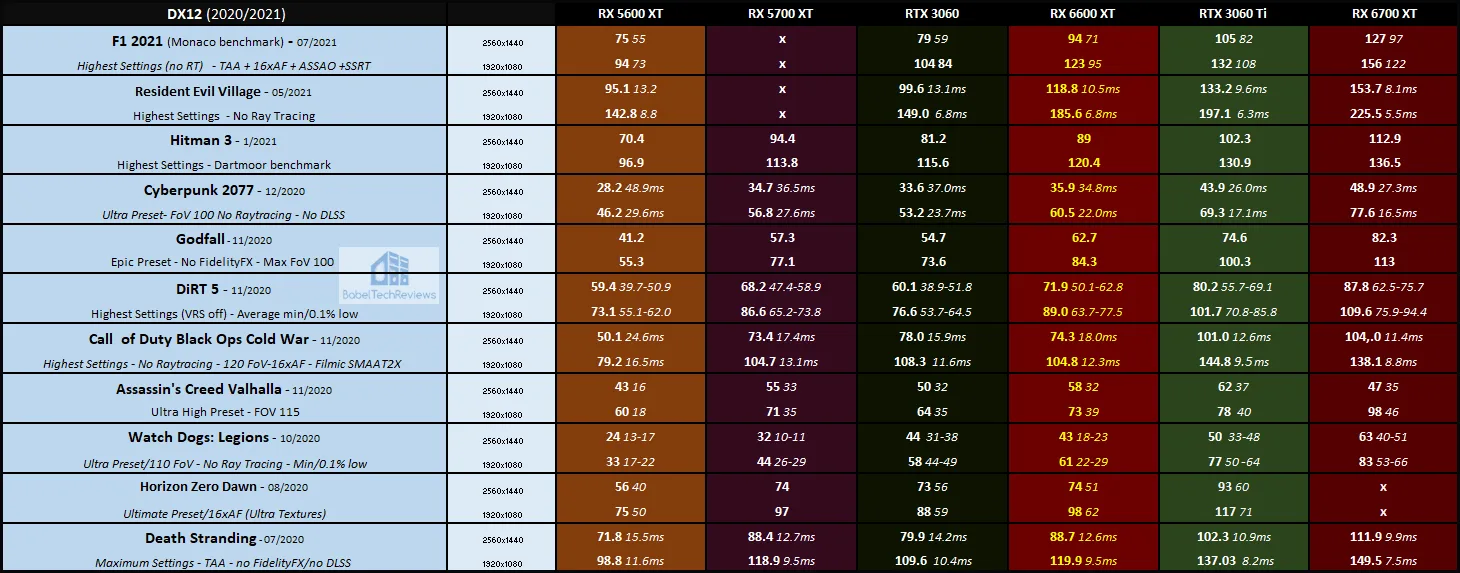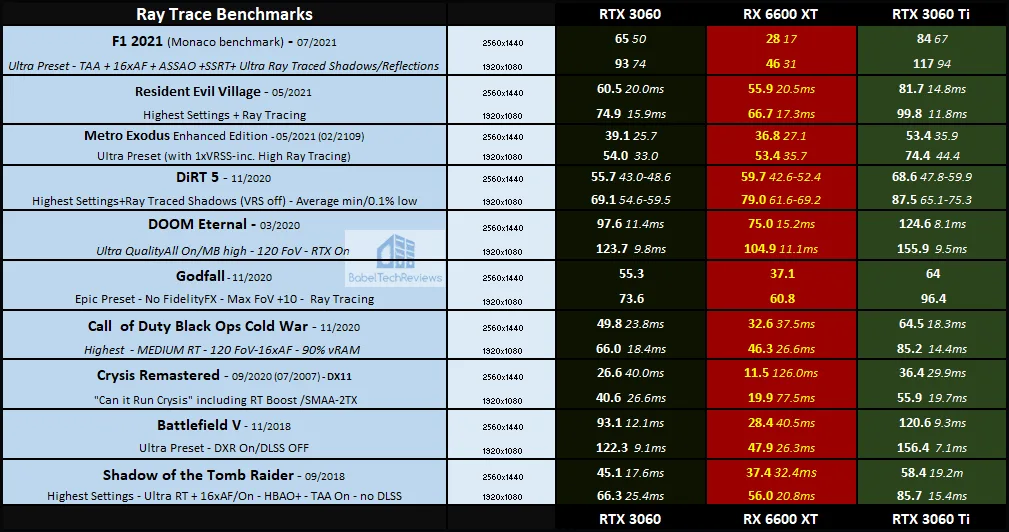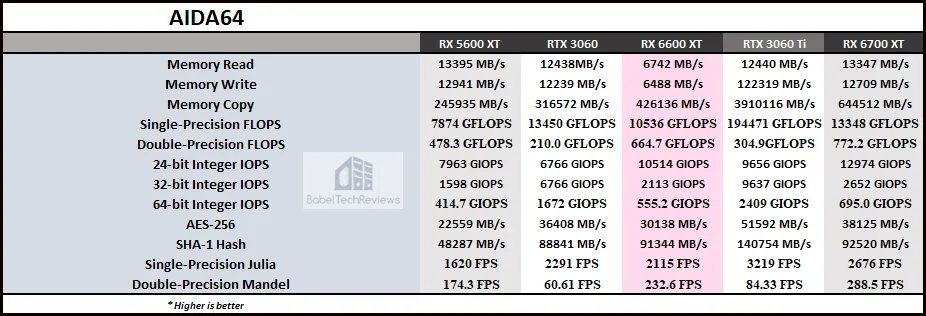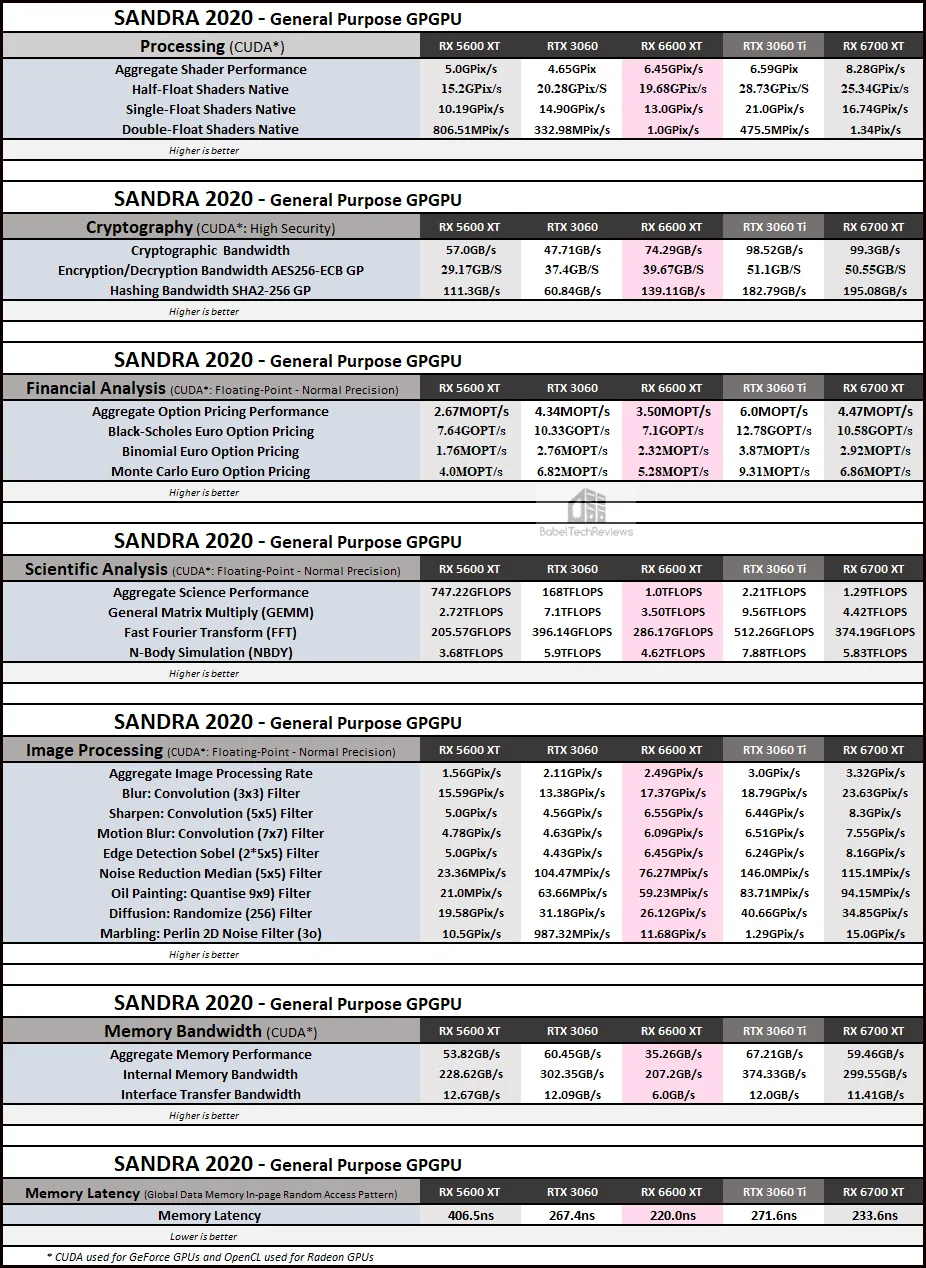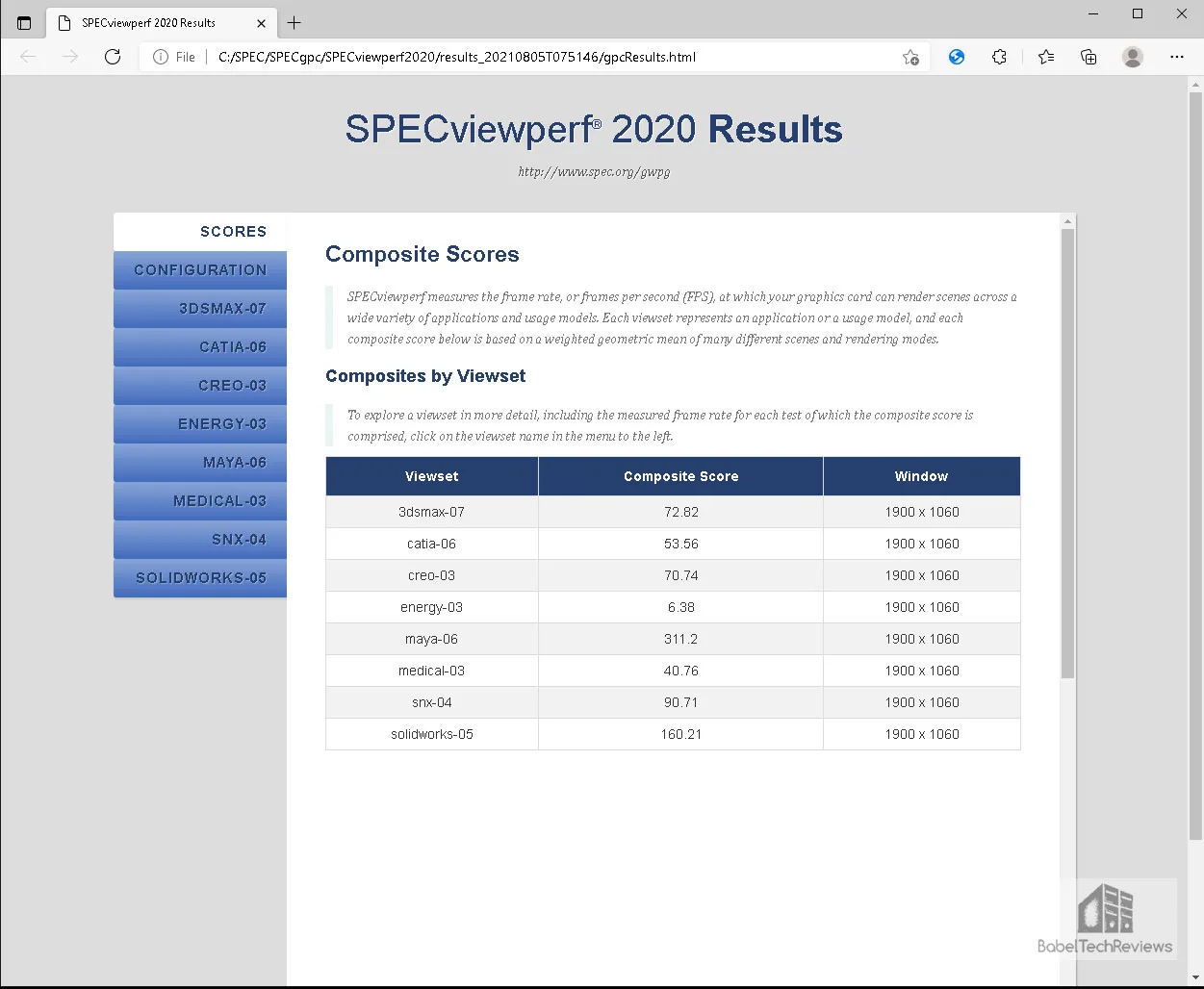The PowerColor Red Devil RX 6600 XT takes on the RTX 3060 & RTX 3060 Ti in 32 Games
The Red Devil RX 6600 XT arrived at BTR for evaluation from PowerColor as a premium and overclocked 8GB vRAM-equipped 128-bit card with no manufacturer recommended (SEP/MSRP) pricing as yet although the base models start at a rather high $379 considering it is targeting 1080P. We have been exhaustively comparing it versus the $329 RTX 3060 EVGA Black 12GB and versus the $399 RTX 3060 Ti 8GB Founders Edition using 32 games, GPGPU, workstation, SPEC, and synthetic benchmarks.
We will also compare the performance of these competing cards with the RX 6600 XT’s bigger brother, the Red Devil RX 6700 XT (the reference card SEP is $479), and also with its predecessor the ASUS TUF Gaming X3 RX 5600 XT (at $309 which is $30 above AMD’s entry-level pricing of $279); and also with the RX 5700 XT Anniversary Edition ($499/$449 reference at launch).
The Red Devil RX 6600 XT is factory clocked higher than the reference specifications using its OC BIOS. While the reference Radeon RX 6600 XT offers a Game clock up to 2359MHz and a Boost clock of 2589MHz, the PowerColor Red Devil game clocks up to 2428MHz and boosts to 2607MHz. It also looks different from older generation classic Red Devils, arriving in a more neutral gray color instead of in all red and black. The Red Devil RX 6600 XT features a RGB mode whose LEDs default to a bright red which may be customized by PowerColor’s DevilZone software.
The Reference and Red Devil RX 6600 XT Features & Specifications
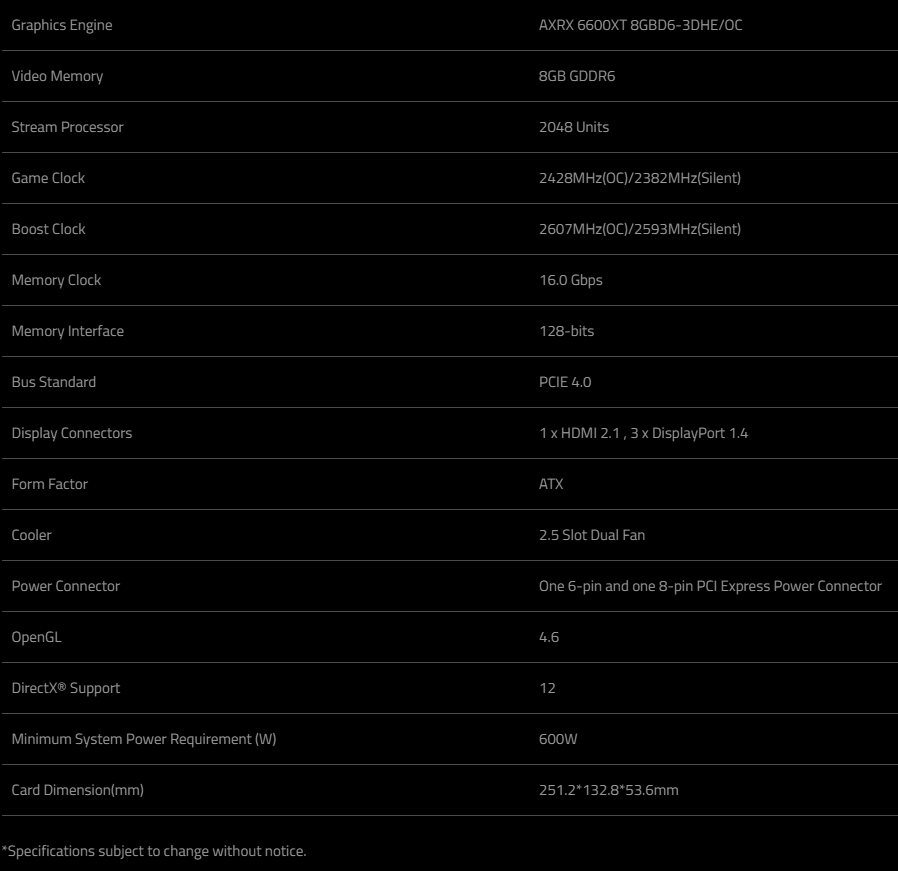
First let’s look at the Red Devil RX 6600 XT specifications:
Additional Information from PowerColor
PowerColor newest 6600 XT Red Devil card, is positioned to compete directly with the custom 3060 premium models.
- The card has 2 modes, OC and Silent. 145W / 135W Power target. There’s a bios switch on the side of the card. We designed this card to be very quiet, even on performance mode is considerably quieter most silent cards, but we also advise to try the silent mode as it’s truly whisper quiet, with a normal case with a optimal airflow, you most likely see the card run around 1000 Rpms under this mode.
- The board has 10 Phase VS the 6+2 Phase VRM design on the standard designs meaning is over spec’d in order to deliver the best
stability and overclock headroom by having such VRM it will run cooler and last longer. - DrMos and high-polymer Caps are used on our Design, no compromises.
- DUAL FAN, at this TDP there is no need of oversized 3 fan coolers, better sized and yet efficient cooling!
- Our cooler features 2 x 100mm ,all with two ball bearing fans with 4 heat pipes (4X6Φ) across the high density heatsink with large nickel plated base.
- RGB is enhanced, Red Devil now connects to the motherboard aRGB (5v 3 pin connector) for RGB Sync.
- Red Devil has Mute fan technology, fans stop under 60c!
- The ports are LED illuminated. Now you can see in the dark where to plug.
- The card back plate does not have thermal pads but instead we did cuts across the backplate for the PCB to breath, which under high
heat scenarios is more beneficial than having thermal pads as the back plate can become a heat trap. - Red Devil buyers will be able to join exclusive giveaway as well access to the Devil Club website. A membership club for Devil users only which gives them access to News, Competitions, Downloads and most important instant support via Live chat.
RX 6000 features
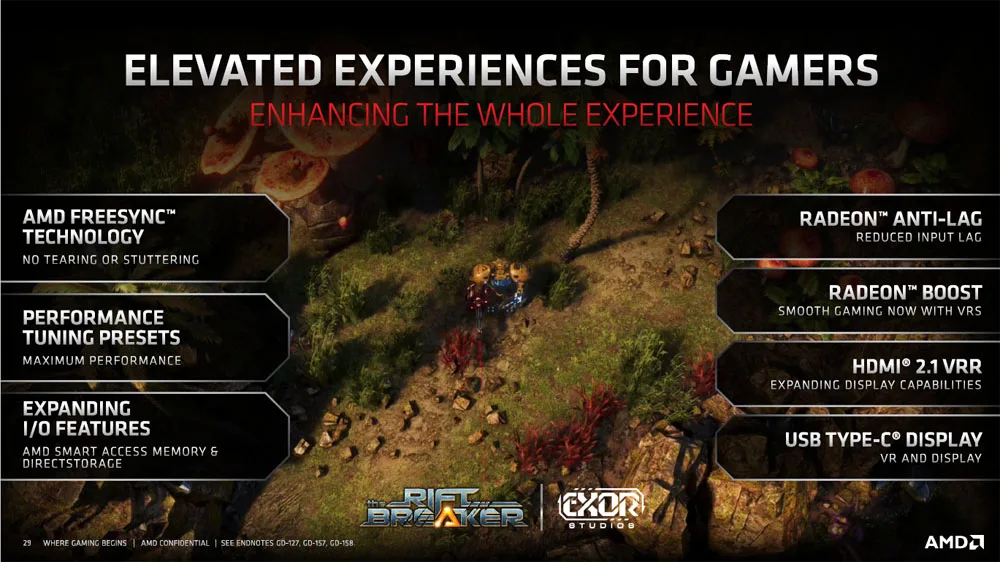
AMD has their own ecosystem for gamers and many unique new features for the Radeon 6000 series. However, the above slide from AMD does not mention two features – the Infinity Cache and Smart Access Memory.
Infinity Cache & Smart Access Memory
AMD’s RDNA 2 architecture includes the Infinity Cache which alters the way data is delivered to GPUs. This global cache allows fast data
access and increases bandwidth. This optimized on-die cache uses 96MB of AMD Infinity Cache delivering up to 2.5x the effective bandwidth compared to 256-bit 12Gbps GDDR6.
BTR uses Intel’s 10th generation flagship CPU, the i9-10990K which does not have this cache available so our results will probably be lower than what a gamer using a full Ryzen 5000 platform will achieve. In addition, we don’t have Smart Access Memory.
AMD’s Smart Access Memory is a new feature for the Radeon RX 6000 Series graphics cards that enables additional memory space to be mapped to the base address register resulting in performance gains for select games when paired with an AMD Ryzen 5000 Series processor or with some Ryzen 3000 series CPUs. Using PCIe, the Base Address Register (BAR) defines how much GPU memory space can be mapped. Without using Smart Access Memory, CPUs can generally access up to 256MB of GPU memory restricting performance somewhat.
NVIDIA has worked with its partners and with Intel to enable Resizable BAR which currently is enabled for the EVGA Z490 FTW motherboard but it only works for GeForce cards. When we tried to enable it for the RX 6600 XT, our PC refused to boot after following AMD’s instructions using a clean installation of Windows. So we disabled it and tested all of our video cards and games without Resizable BAR.
The Test Bed
BTR’s test bed consists of 32 games and 3 synthetic game benchmarks at 1920×1080 and 2560×1440, as well as SPEC, workstation, and GPGPU benchmarks. Our latest games include Chernobylite and F1 2021. The testing platform uses a recent installation of Windows 10 64-bit Pro Edition, and our CPU is an i9-10900K which turbos all 10 cores to 5.1/5.0GHz, an EVGA Z490 FTW motherboard, and 32GB of T-FORCE Dark Z DDR4 at 3600MHz. The games, settings, and hardware are identical except for the cards being compared.
First, let’s take a closer look at the new PowerColor Red Devil RX 6600 XT.
A Closer Look at the Red Devil RX 6600 XT
 Although the Red Devil RX 6600 XT advertises itself as a premium 7nm 8GB vRAM-equipped card on AMD’s RDNA 2 architecture which features 1080P and PCIe 4.0, the cover of the box favors stylized imagery over text.
Although the Red Devil RX 6600 XT advertises itself as a premium 7nm 8GB vRAM-equipped card on AMD’s RDNA 2 architecture which features 1080P and PCIe 4.0, the cover of the box favors stylized imagery over text.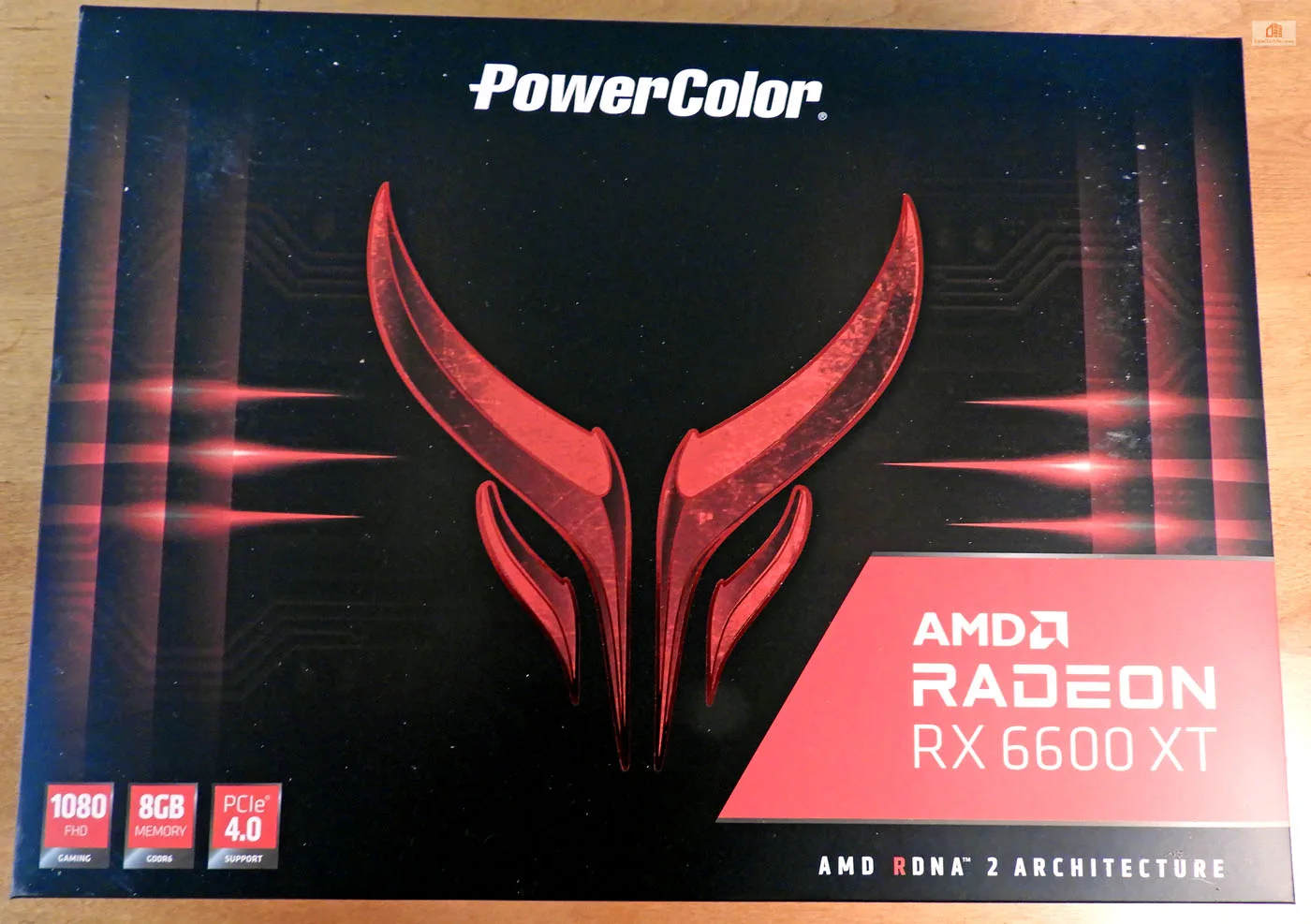
The back of the box touts key features which now include HDMI 2.1 VRR, ray tracing technology, FidelityFX, and VR Ready Premium as well as states its 600W power and system requirements. 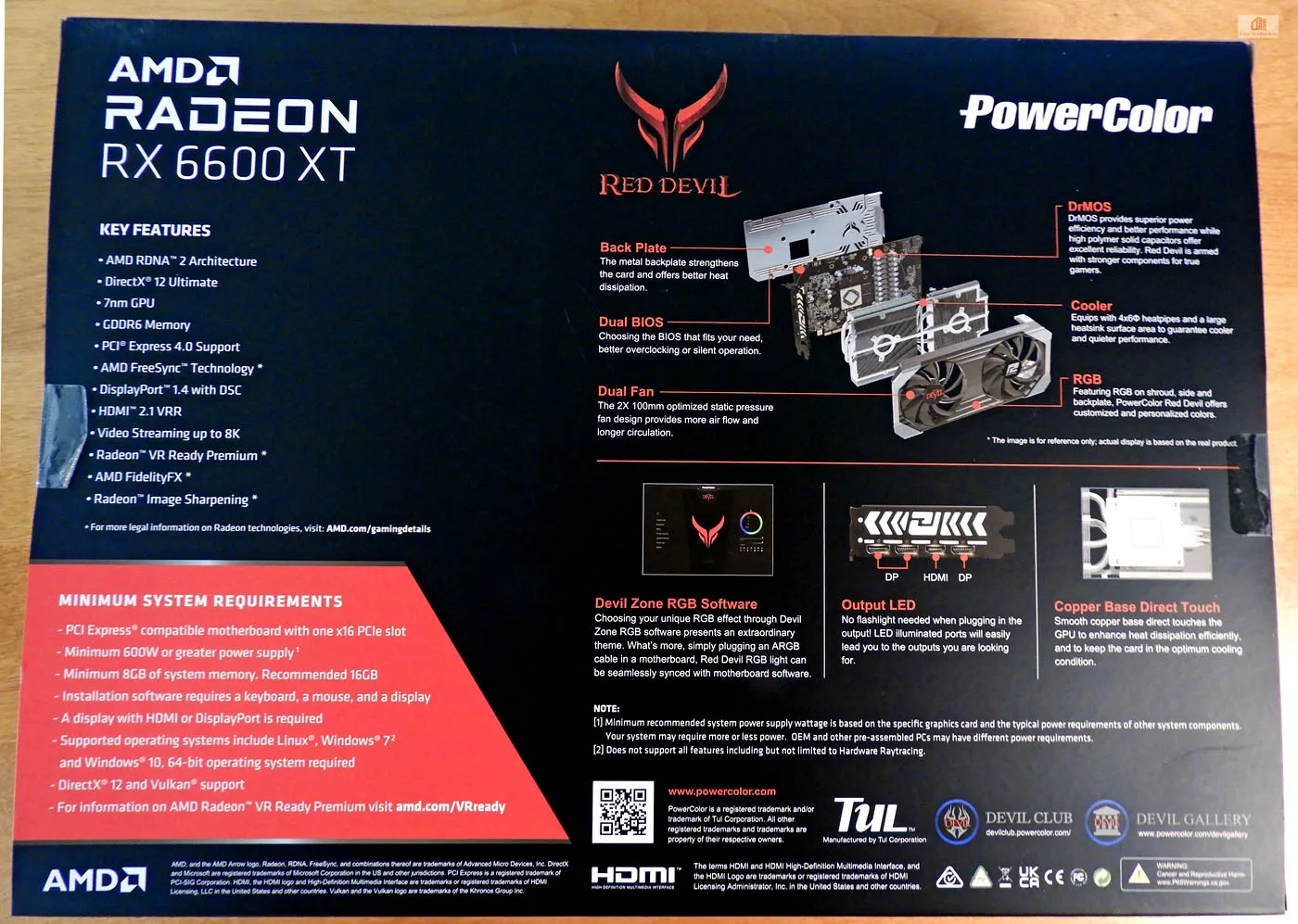 AMD’s technology features are highlighted and the box features PowerColor’s custom cooling solution, Dual-BIOSes, RGB software and output LEDs, and a solid backplate with the Red Devil logo that also lights up.
AMD’s technology features are highlighted and the box features PowerColor’s custom cooling solution, Dual-BIOSes, RGB software and output LEDs, and a solid backplate with the Red Devil logo that also lights up.
Opening its very well-padded box, we see a quick installation guide, a RGB LED cable, and an invitation to join PowerColor’s Devil’s Club.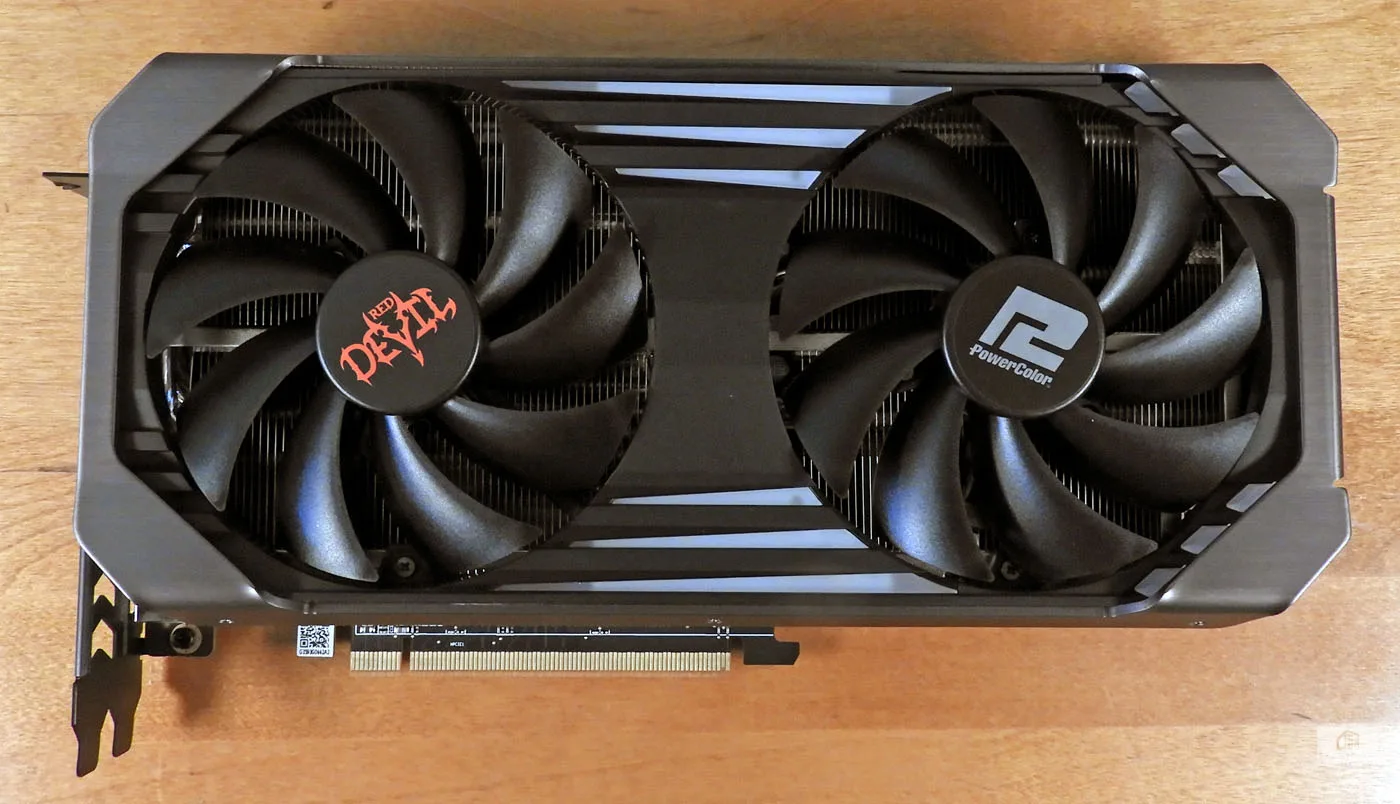
The Red Devil RX 6600 XT is a dual-fan card. Turning the Red Devil over (below) we see a solid backplate that features the devil logo that also lights up.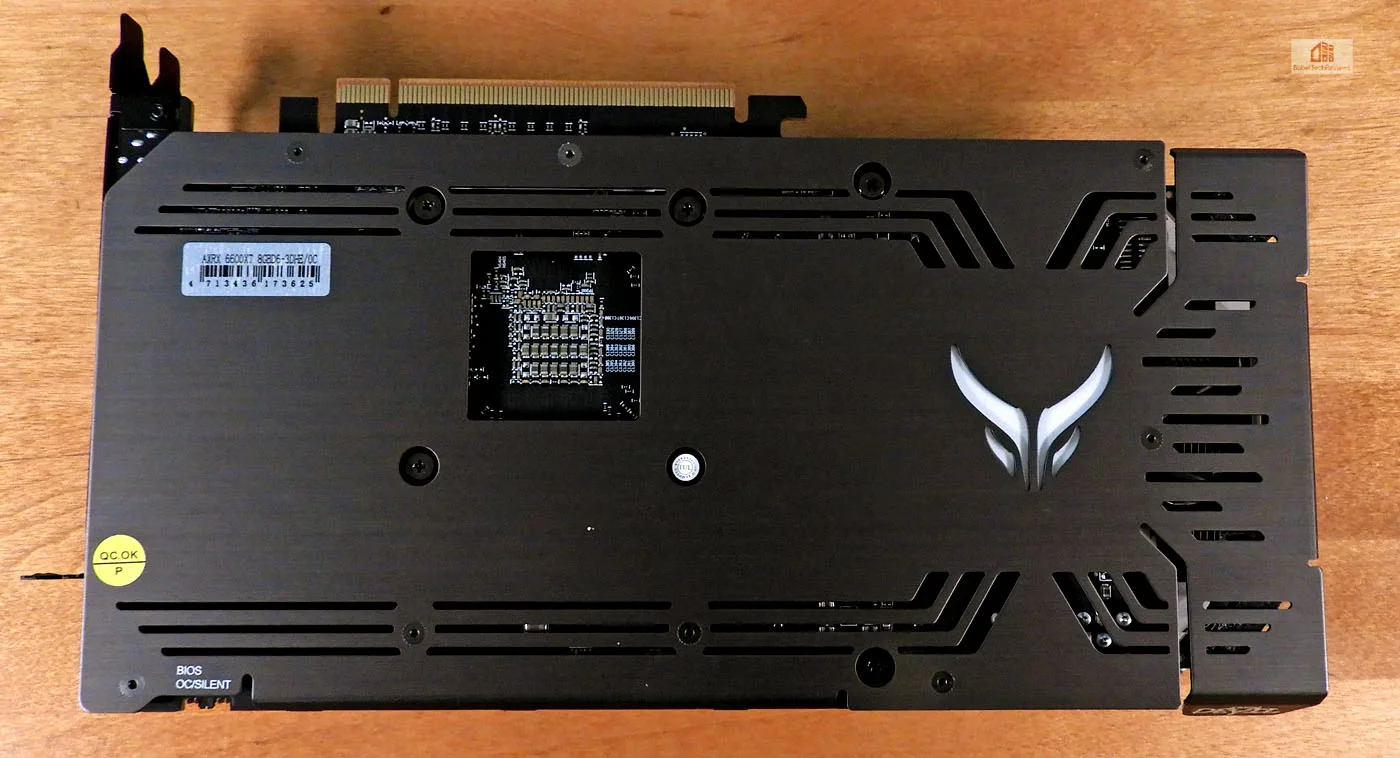
The Red Devil RX 6600 XT is a medium-sized dual-fan card (251mm long x 133mm tall x 54mm thick) in a 2 slot design which is quite handsome with PowerColor’s colors and even more striking with the RGB on. There is also a switch to choose between the default overclock (OC) BIOS and the Silent BIOS (above, right). Using the OC BIOS the card has a 145W power target and using the Silent BIOS it has a 135W power target. We didn’t bother with the Silent BIOS as the card is very quiet using the OC BIOS, but it is good to have in case a flash goes bad.
There is also a switch to choose between the default overclock (OC) BIOS and the Silent BIOS (above, right). Using the OC BIOS the card has a 145W power target and using the Silent BIOS it has a 135W power target. We didn’t bother with the Silent BIOS as the card is very quiet using the OC BIOS, but it is good to have in case a flash goes bad.
 The Red Devil uses one 1×8-pin and 1×6-pin PCIe connections while the reference version uses 1×8-pin. We would suggest that with the current voltage limitations and low power draw, the extra connector is probably not really necessary even for overclocking unless the end user circumvents the power restrictions using MPT at their own risk. Looking at the edges, we can see it is all heatsink fins for cooling as is typical of Red Devil cards, and we expect it to run cool.
The Red Devil uses one 1×8-pin and 1×6-pin PCIe connections while the reference version uses 1×8-pin. We would suggest that with the current voltage limitations and low power draw, the extra connector is probably not really necessary even for overclocking unless the end user circumvents the power restrictions using MPT at their own risk. Looking at the edges, we can see it is all heatsink fins for cooling as is typical of Red Devil cards, and we expect it to run cool.
Above, the PowerColor Red Devil RX 6600 XT’s other end also lights up giving the card an aggressive look.
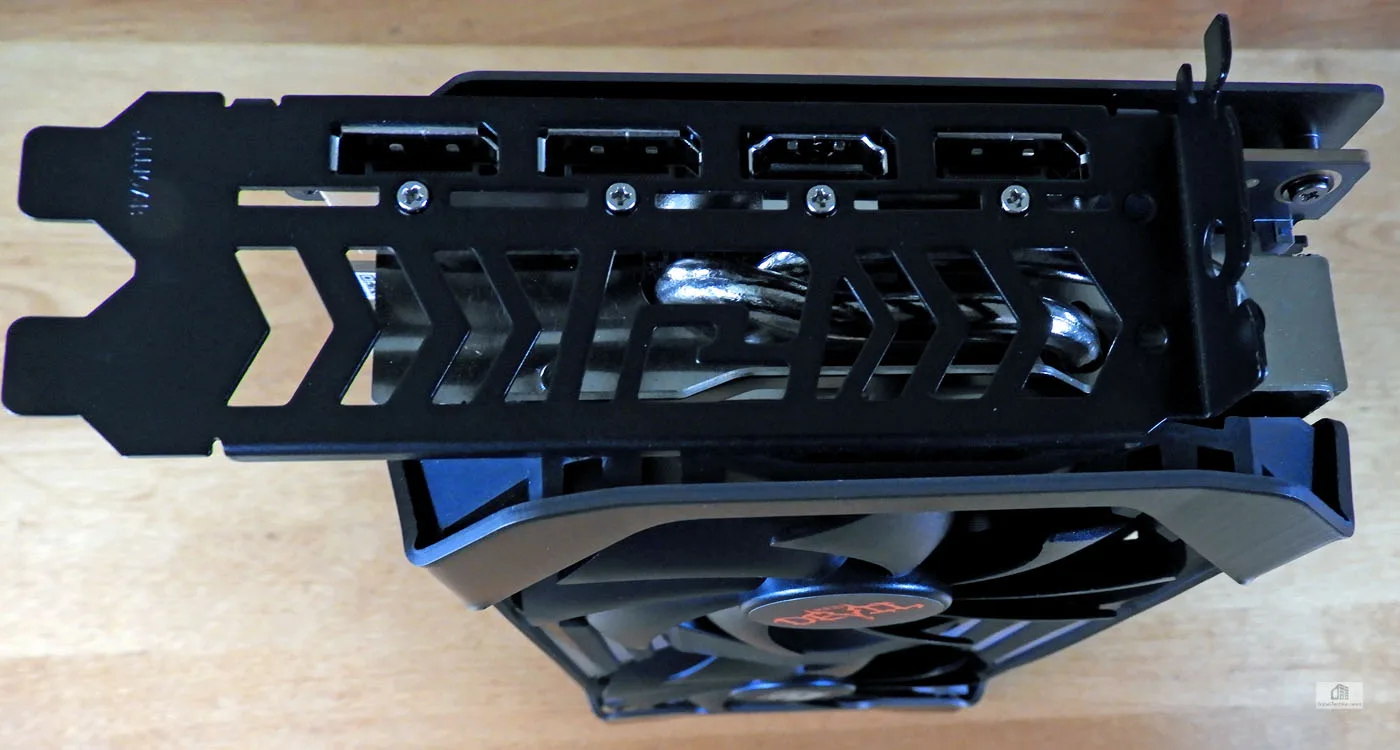
The Red Devil’s RX 6600 XT’s connectors include 3 DisplayPorts and 1 HDMI connector. There is an LED that illuminates this panel for making easier connections in the dark.
The Red Devil looks great when it is running in a PC.
The specifications look good and the Red Devil itself looks great with its default RGB bright red contrasting with the black backplate and its aggressively lit-up front end perhaps is stylistically reminiscent of an automotive grill or perhaps teeth. The end user may enhance and coordinate the RGB colors by connecting to the motherboard using a supplied aRGB (5v 3-pin) connector using the DevilZone RGB software.
Let’s check out its performance after we look over our test configuration and more on the next page.
Test Configuration – Hardware
- Intel Core i9-10900K (HyperThreading/Turbo boost On; All cores overclocked to 5.1GHz/5.0Ghz. Comet Lake DX11 CPU graphics)
- EVGA Z490 FTW motherboard (Intel Z490 chipset, v1.9 BIOS, PCIe 3.0/3.1/3.2 specification, CrossFire/SLI 8x+8x), supplied by EVGA
- T-FORCE DARK Z 32GB DDR4 (2x16GB, dual channel at 3600MHz), supplied by Team Group
- Red Devil RX 6600 XT 8GB, factory settings and overclocked, on loan from PowerColor
- Red Devil RX 6700 XT 12GB, factory settings and overclocked, on loan from PowerColor
- ASUS TUF Gaming X3 RX 5600 XT 6GB, stock settings, on loan from ASUS
- Radeon RX 5700 XT 8GB Anniversary Edition, stock AE clocks.
- EVGA RTX 3060 Black 12GB, stock clocks, on loan from EVGA
- RTX 3060 Ti Founders Edition 8GB, stock clocks, on loan from NVIDIA
- 2 x 1TB Team Group MP33 NVMe2 PCIe SSD for C: drive; one for AMD and one for NVIDIA
- 1.92TB San Disk enterprise class SATA III SSD (storage)
- 2TB Micron 1100 SATA III SSD (storage)
- 1TB Team Group GX2 SATA III SSD (storage)
- 1GB T-FORCE Delta MAX SSD (storage), supplied by Team Group
- ANTEC HCG1000 Extreme, 1000W gold power supply unit
- Samsung G7 Odyssey (LC27G75TQSNXZA) 27″ 2560×1440/240Hz/1ms/G-SYNC/HDR600 monitor
- DEEPCOOL Castle 360EX AIO 360mm liquid CPU cooler
- Phanteks Eclipse P400 ATX mid-tower (plus 1 Noctua 140mm fan)
Test Configuration – Software
- Adrenalin 2021 Edition 21.7.1 press drivers used for the RX 6600 XT and 21.7.2 used for the other Radeons except for 21.2.3 used for the RX 5700 XT.
- GeForce 471.41 for the RTX 3060 and the RTX 3060 Ti.
- High Quality, prefer maximum performance, single display, set in the NVIDIA control panel; Vsync off.
- All optimizations are off, Vsync is forced off, Texture filtering is set to High, and Tessellation uses application settings in the AMD control panel.
- AA enabled as noted in games; all in-game settings are specified with 16xAF always applied
- Highest quality sound (stereo) used in all games
- All games have been patched to their latest versions
- Gaming results show average frame rates in bold including minimum frame rates shown on the chart next to the averages in a smaller italics font where higher is better. Games benched with OCAT show average framerates but the minimums are expressed by frametimes (99th-percentile) in ms where lower numbers are better.
- Windows 10 64-bit Pro edition; latest updates. DX11 titles are run under the DX11 render path. DX12 titles are generally run under DX12, and multiple games use the Vulkan API.
- Latest DirectX
Games
Vulkan
- DOOM Eternal
- Red Dead Redemption 2
- Ghost Recon: Breakpoint
- World War Z
- Strange Brigade
- Rainbow 6 Siege
DX12
- F1 2021
- Resident Evil Village
- Hitman 3
- Cyberpunk 2077
- DiRT 5
- Godfall
- Call of Duty Black Ops: Cold War
- Assassin’s Creed: Valhalla
- Watch Dogs: Legion
- Horizon Zero Dawn
- Death Stranding
- Tom Clancy’s The Division 2
- Borderlands 3
- Metro Exodus & Metro Exodus Enhanced Edition
- Civilization VI – Gathering Storm Expansion
- Battlefield V
- Shadow of the Tomb Raider
- Forza 7
DX11
- Chernobylite
- Days Gone
- Crysis Remastered
- Destiny 2 Shadowkeep
- Total War: Three Kingdoms
- Far Cry New Dawn
- Assetto Corsa: Competitione
- Grand Theft Auto V
Synthetic
- TimeSpy (DX12)
- 3DMark FireStrike – Ultra & Extreme
- Superposition
- Heaven 4.0 benchmark
- AIDA64 GPGPU benchmarks
- Blender 2.931 benchmark
- Sandra 2021 GPGPU Benchmarks
- SPECworkstation3
- SPECviewperf 2020
NVIDIA Control Panel settings
Here are the NVIDIA Control Panel settings.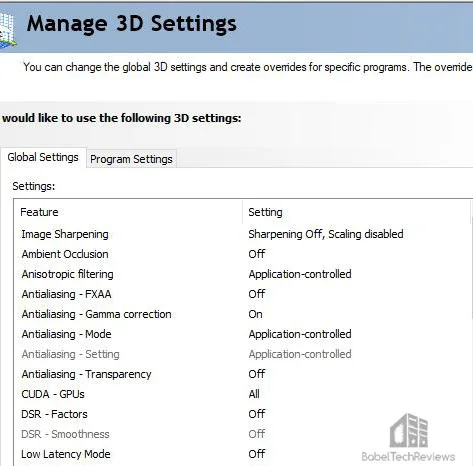


Next the AMD settings.
AMD Adrenalin Control Center Settings
All AMD settings are set so that all optimizations are off, Vsync is forced off, Texture filtering is set to High, and Tessellation uses application settings. All Navi cards are capable of high Tessellation unlike earlier generations of Radeons.
Anisotropic Filtering is disabled by default but we always use 16X for all game benchmarks.
Let’s check out overclocking, temperatures and noise next.
Overclocking, temperatures and noise
We spent a lot of time overclocking the Red Devil RX 6600 XT for this review. The Red Devil is factory clocked higher than the reference specifications using its OC BIOS. While the reference Radeon RX 6600 XT offers a Game clock up to 2359MHz and a Boost clock of 2589MHz, the PowerColor Red Devil game clocks up to 2428MHz and boosts to 2607MHz.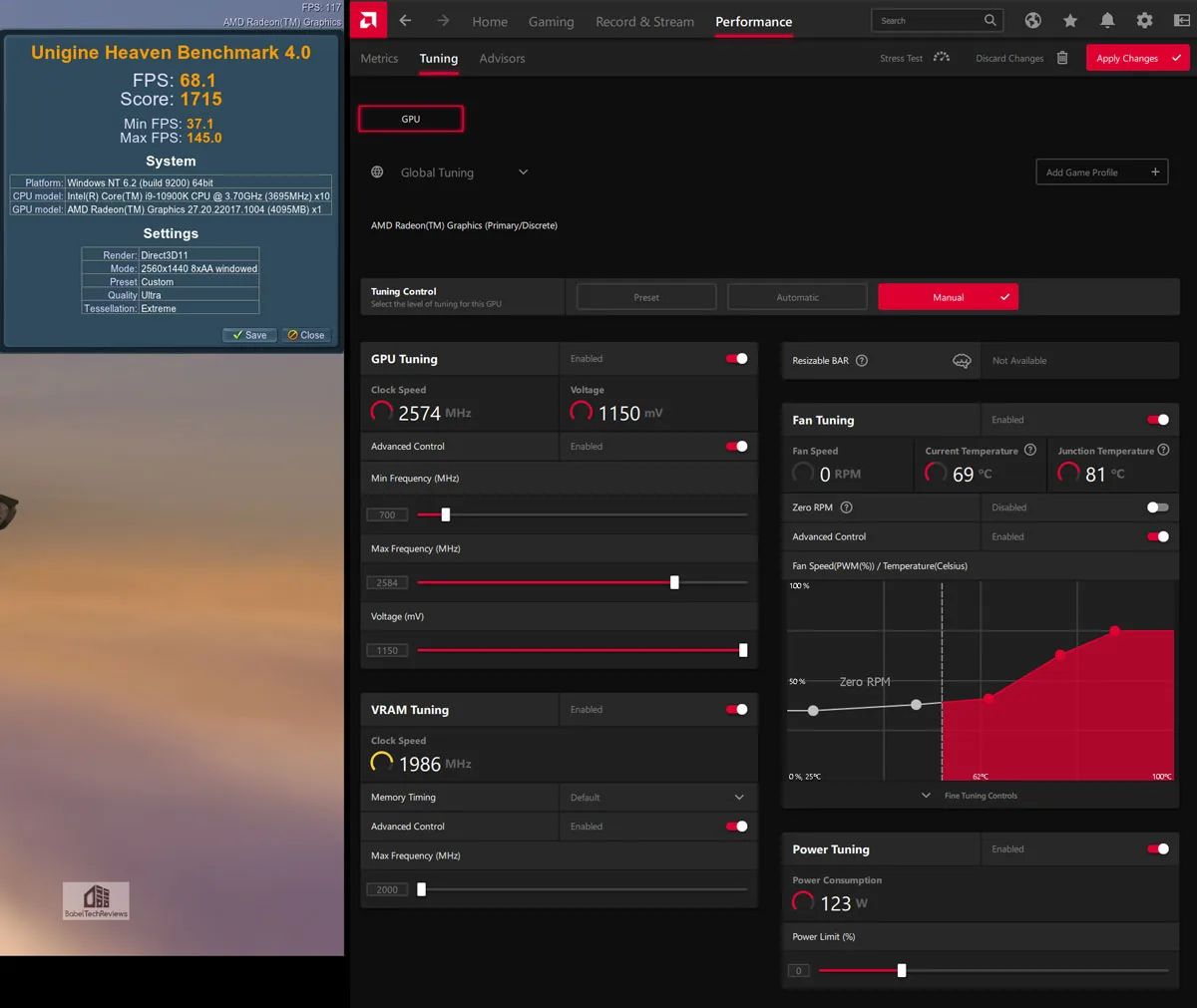
Above are the reference RX 6600 XT Wattman default settings which include leaving the power limit at default. The performance didn’t matter whether the power limit was set to default or higher even when overclocked. Although the Red Devil boosts to 2607MHz, we typically saw clocks at around 2575MHz and the GPU stayed cool. The fan speeds are not tracked by Wattman but they remained low and we could not hear them over our other case fans.
The Wattman auto overclock feature is useless as it gave an extremely low overclock so we used trial and error to find Red Devil’s maximum performance at the edge of stability. We settled on increasing the memory to 115% (2284MHz) and increasing the core clock by 7% (2776MHz) as below.
At maximum overclock, the clocks run from 2686MHz to a peak of 2720MHz, but this time the temperatures drop below 60C as the fan speeds increase. Even while overclocked to the max, the Red Devil remains very quiet and cool with power consumption just approaching 140W.
There is a small performance increase from overclocking the RX 6600 XT core by 7% and increasing the memory by 15%. Unfortunately, AMD has again locked all RX 6600 XT cards overclocking down in an attempt to maximize overall performance by limiting the voltage to 1150mV. We would also suggest that the RX 6600 XT is rather voltage constrained and the Red Devil could seriously benefit by more voltage. We suspect that some enthusiast gamers will use MPT (More Power Tool) and risk their warranty to gain a substantially higher Red Devil overclock although we cannot recommend it.
We believe that the Red Devil’s overclock will not degrade over time as its PCB components are fit to run all the time at the highest overclock settings – perhaps unlike entry level versions which are not engineered for ultimate maximum reliability.
Of course, many gamers will want to fine-tune their own overclock and undervolting is a possibility although at 140W the Red Devil RX 6600 XT is not a power hog. Check the overclocking chart in the next section for performance increases using ten key games.
Let’s head to the performance charts to see how the performance of the RX 6600 XT compares with five other cards.
Performance summary charts
Here are the performance results of 32 games and 3 synthetic tests comparing the factory-clocked 8GB Red Devil RX 6600 XT with the EVGA RTX 3060 Black 12GB (reference) and versus the RTX 3060 Ti FE 8GB at their factory set clocks. Three other cards are added for comparison in the Big Picture. The highest settings are used and are listed on the charts. The benches were run at 1920×1080 and at 2560×1440. Click on each chart to open in a pop-up for best viewing.
Most gaming results show average framerates in bold text, and higher is better. Minimum framerates are next to the averages in italics and in a slightly smaller font. The games benched with OCAT show average framerates but the minimums are expressed by frametimes in ms where lower numbers are better.
The Red Devil RX 6600 XT vs. the RTX 3060 & RTX 3060 Ti
The first set of charts show our three main competing cards. Column one represents the RTX 3060 EVGA Black (reference speed) version ($329) performance, column two is the Red Devil RX 6600 XT (no SEP/reference $379), and column three represents the RTX 3060 Ti FE ($399) performance.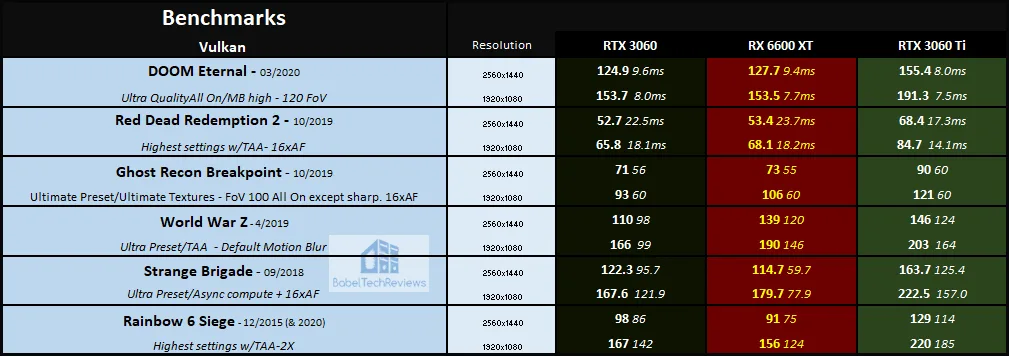
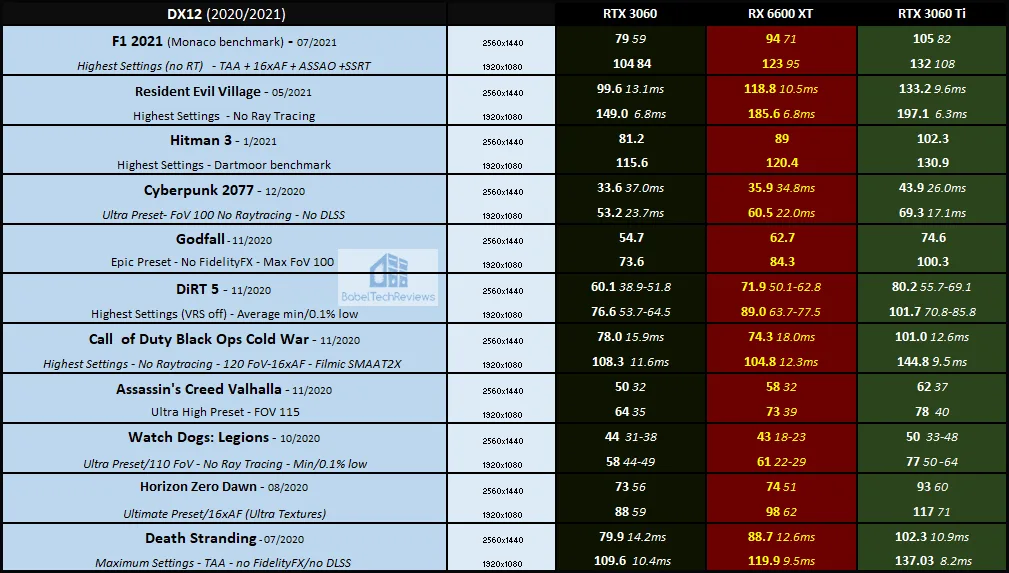
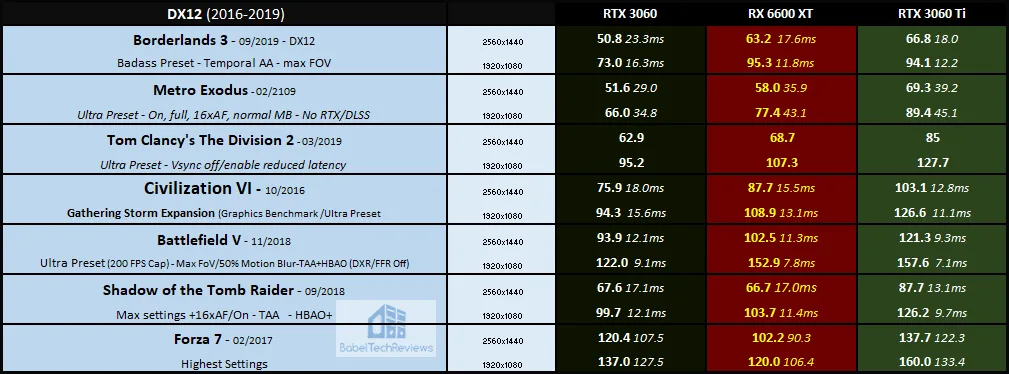
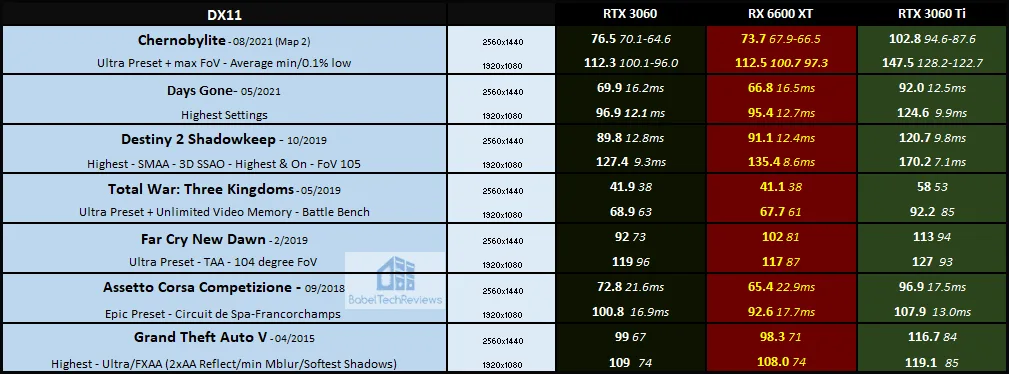

The Red Devil RX 6600 XT is faster overall than the RTX 3060 EVGA Black (reference) version but it is still in the same class, trading blows depending on the games tested. Since we do not use Resizable BAR or have Smart Access Memory, we expect that some games would shift in favor of the Radeon using a Ryzen 5000 platform. However, it is outclassed by the $20 more expensive RTX 3060 Ti, winning no games against it.
Let’s see how the reference and Red Devil RX 6600 XT fit in with our expanded main summary chart, the “Big Picture”, comparing a total of six cards.
The Big Picture
Here is how the Red Devil 6600 XT fits into a larger chart with six cards. The ASUS RX 5600 XT is in column one, the RX 5700 XT (Anniversary Edition) is in column 2, the EVGA Black RTX 3060 is in column 3, the Red Devil RX 6600 XT is in Column 4, the RTX 3060 Ti FE is in column 5, and the Red Devil RX 6700 XT is in column 6.
We see that the RX 6600 XT is a fair upgrade from the RX 5600 XT, but it is hard to believe that AMD has increased the price by $100 over the last midrange 1080P generation. The RX 6600 XT basically trades blows with the RX 5700 XT which launched at $399. We have to wonder what AMD was thinking when they set their pricing so high.
Ray Traced Benchmarks
The Red Devil RX 6600 XT is next compared with our other two main competing cards when ray tracing is enabled in ten games. No DLSS or FSR technologies are used.
The RX 6600 XT gets outperformed overall when compared with the $50 less expensive RTX 3060 after ray tracing is enabled. However, AMD has recently introduced FidelityFX Super Resolution (FSR) which is their answer to NVIDIA’s DLSS.
FidelityFX Super Resolution (FSR)
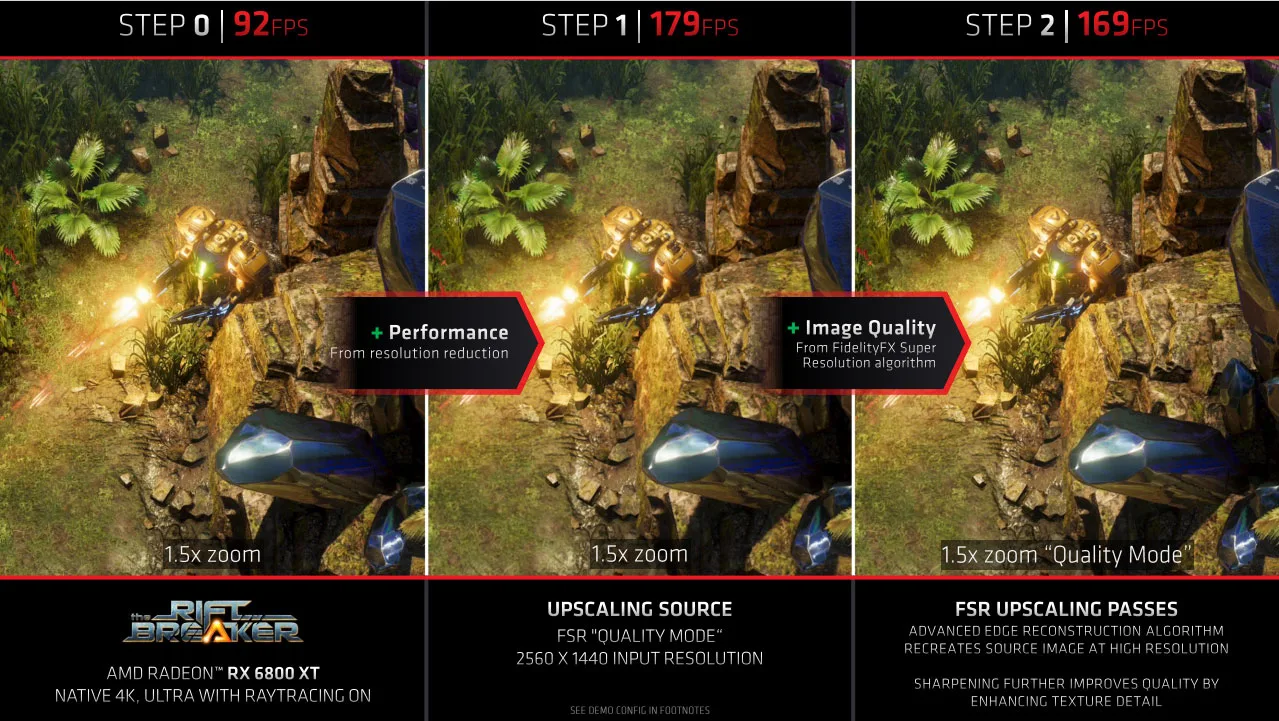
FSR improves performance by first rendering frames at a lower resolution and then by using an open-source spatial upscaling algorithm with a sharpening filter in an attempt to make the game look nearly as good as at native resolution. NVIDIA’s DLSS is a more mature temporal upscaling solution that uses AI/Deep Learning. With DLSS, data is accumulated from multiple frames and combined into the final image with the AI reconstruction component running on GeForce RTX Tensor cores.
In contrast, FSR is basically a post-process shader which also makes it easy for game developers to implement across all graphics cards and not just for Radeons. So far, there are about a dozen games that use it and we have tested three games that use FSR. Although Ultra FSR is not the equal of DLSS – and especially not of DLSS 2.0 Quality which rivals and sometimes improves on the native image – it is still a very solid non-AI/temporal upscaler that provides good performance improvements.
Ultra FSR is far more than a standard Lanczos implementation plus sharpening and it brings good value to Radeons (and for all video cards!) for higher “free” performance with a minimal hit to visuals. We were especially impressed with the Ultra FSR implementation in Chernobylite. Below is a performance comparison of Quality DLSS 2.0 versus Ultra FSR.
We see the RX 6600 XT improve its framerates using Ultra FSR to match the RTX 3060 which uses Quality DLSS in Chernobylite.
Again, we see solid performance improvements with Godfall and in Resident Evil Village using Ultra FSR.
Next we look at overclocked performance.
Overclocked benchmarks
These ten benchmarks were run with both Red Devil RX 6600 XT overclocked as far as it can go while remaining stable as described in the overclocking section. The Red Devil manually overclocked card results are presented first and the factory-clocked results are in the second column.
There is a reasonable performance increase from manually overclocking the Red Devil RX 6600 XT beyond its factory clocks from about 2% up to around 10%.
Let’s look at non-gaming applications next to see if the RX 6600 XT is a good upgrade from the other video cards we test starting with Blender.
Blender 2.931 Benchmark
Blender is a very popular open source 3D content creation suite. It supports every aspect of 3D development with a complete range of tools for professional 3D creation.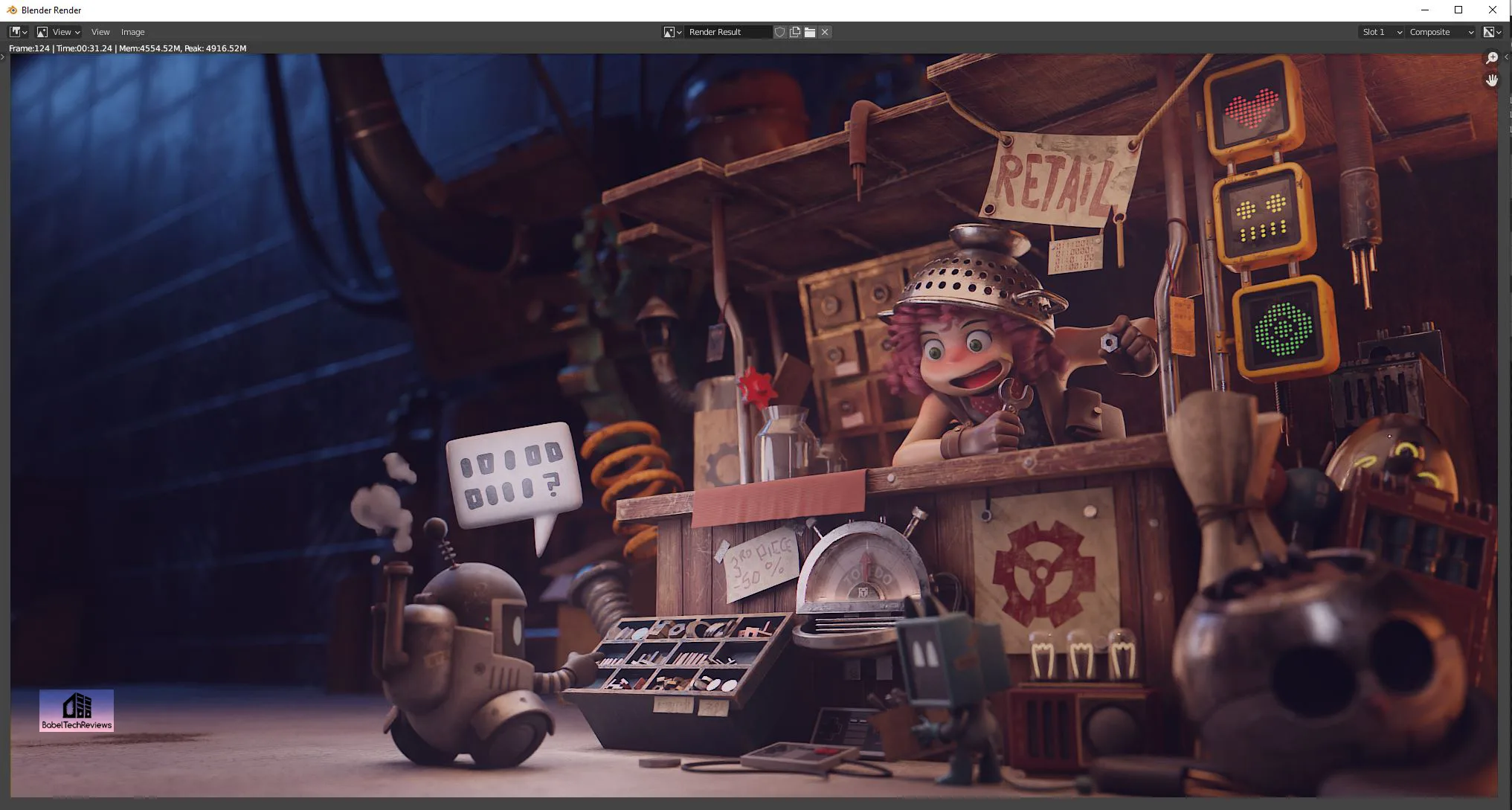
We benchmarked three Blender benchmarks which measure GPU performance by timing how long it takes to render production files. We tested our comparison cards using OpenCL for the Radeons and CUDA on GeForce – all running on the GPU instead of using the CPU.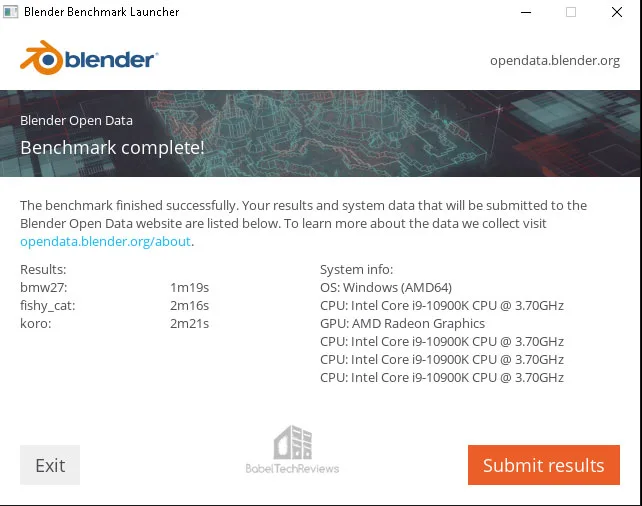
For the following chart, lower is better as the benchmark renders a scene multiple times and gives the results in minutes and seconds.
OpenCL is not as well-optimized for Radeons compared with CUDA for GeForce.
Next, we move on to AIDA64 GPGPU benchmarks.
AIDA64 v6.32
AIDA64 is an important industry tool for benchmarkers. Its GPGPU benchmarks measure performance and give scores to compare against other popular video cards.
AIDA64’s benchmark code methods are written in Assembly language, and they are well-optimized for every popular AMD, Intel, NVIDIA and VIA processor by utilizing the appropriate instruction set extensions. We use the Engineer’s full version of AIDA64 courtesy of FinalWire. AIDA64 is free to to try and use for 30 days. CPU results are also shown for comparison.
Here are the Red Devil RX 6600 XT AIDA64 GPGPU results compared with an overclocked i9-10900K.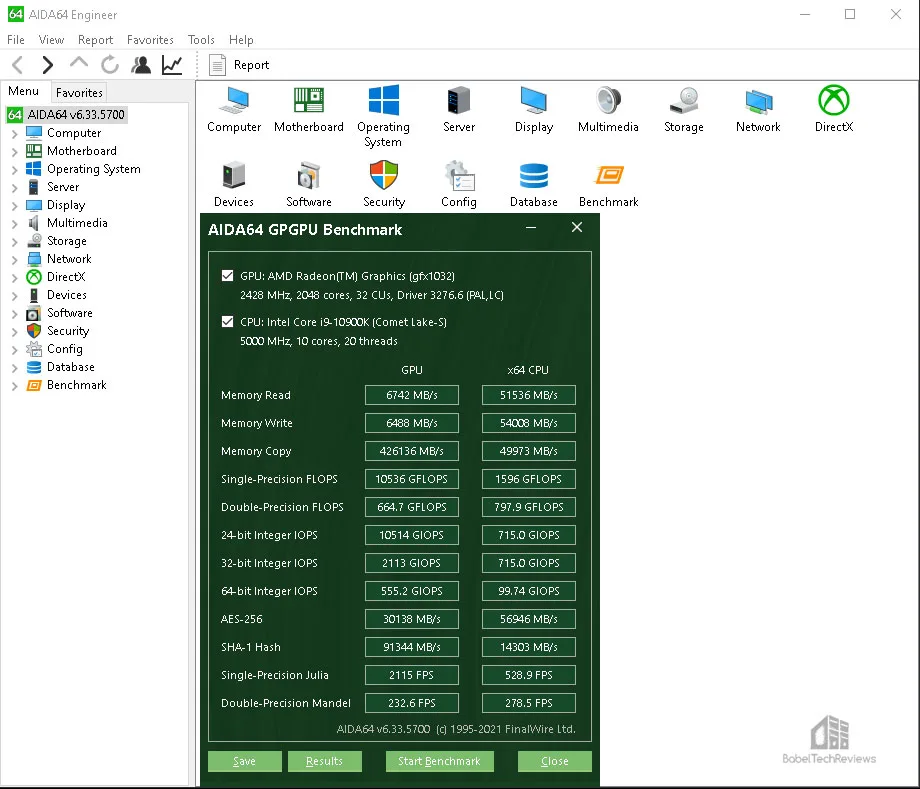
Here is the chart summary of the AIDA64 GPGPU benchmarks with five of our competing cards side-by-side.
The RX 6600 XT is a fast GPGPU card and it compares favorably with Ampere cards, being weaker in some areas and stronger in others, and it’s a solid improvement over the last generation RX 5600 XT. So let’s look at Sandra 2020 next.
SiSoft Sandra 2020
To see where the CPU, GPU, and motherboard performance results differ, there is no better tool than SiSoft’s Sandra 2020. SiSoftware SANDRA (the System ANalyser, Diagnostic and Reporting Assistant) is a excellent information & diagnostic utility in a complete package. It is able to provide all the information about your hardware, software, and other devices for diagnosis and for benchmarking. Sandra is derived from a Greek name that implies “defender” or “helper”.
There are several versions of Sandra, including a free version of Sandra Lite that anyone can download and use. Sandra 2021 is the latest version, and we are using the full engineer suite courtesy of SiSoft. Sandra 2020 features continuous multiple monthly incremental improvements over earlier versions of Sandra. It will benchmark and analyze all of the important PC subsystems and even rank your PC while giving recommendations for improvement.
We ran Sandra’s intensive GPGPU benchmarks and charted the results summarizing them.
In Sandra GPGPU benchmarks, since the architectures are different, each card exhibits different characteristics with different strengths and weaknesses. However, we see solid improvements of the RX 6600 XT over the RX 5600 XT.
SPECworkstation3 (3.0.4) Benchmarks
All the SPECworkstation3 benchmarks are based on professional applications, most of which are in the CAD/CAM or media and entertainment fields. All of these benchmarks are free except for vendors of computer-related products and/or services.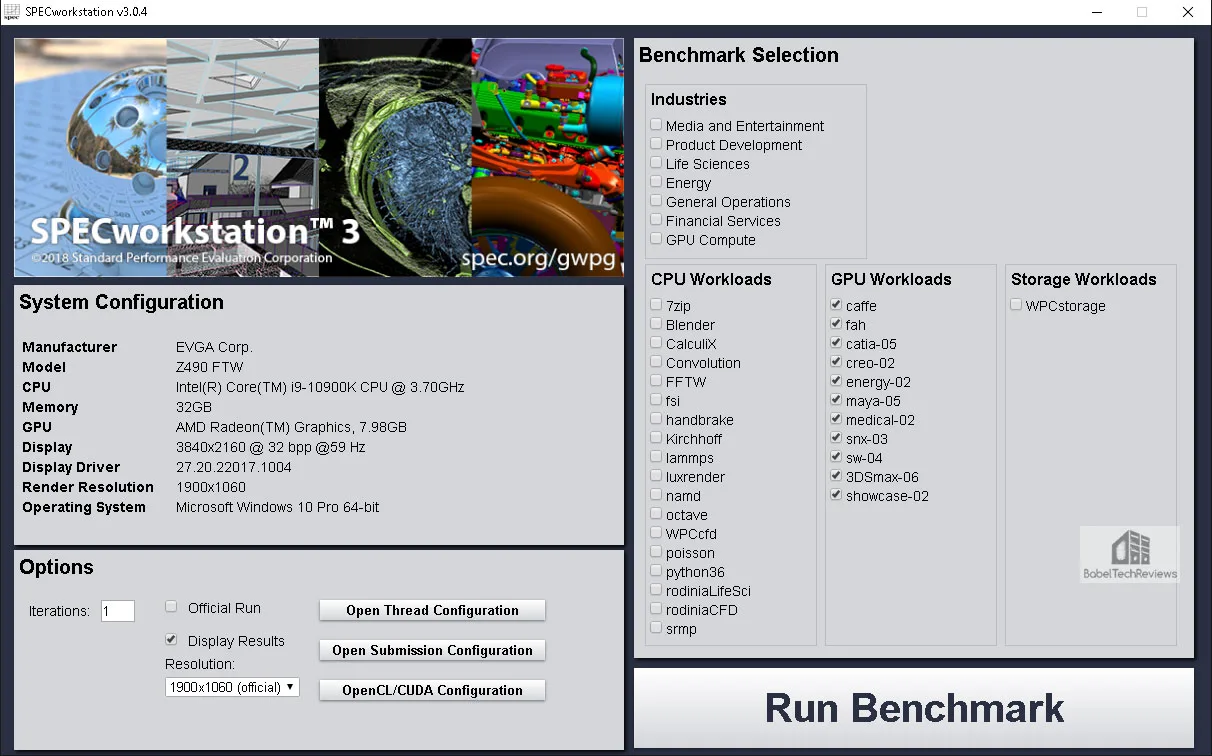
The most comprehensive workstation benchmark is SPECworkstation3. It’s a free-standing benchmark which does not require ancillary software. It measures GPU, CPU, storage and all other major aspects of workstation performance based on actual applications and representative workloads. We only tested the GPU-related workstation performance as checked in the image above.
Here are our raw SPECworkstation 3.0.4.summary and raw scores for the Red Devil RX 6600XT that were tested at 1900×1060.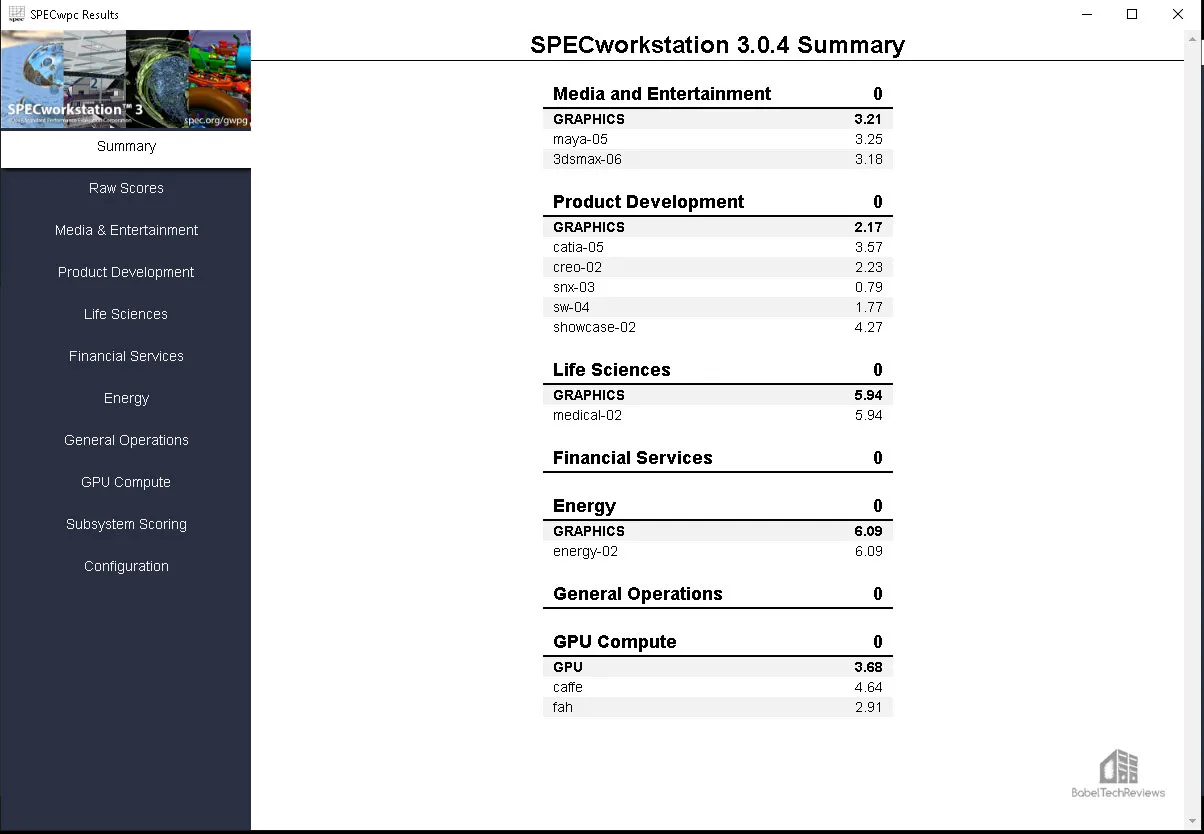
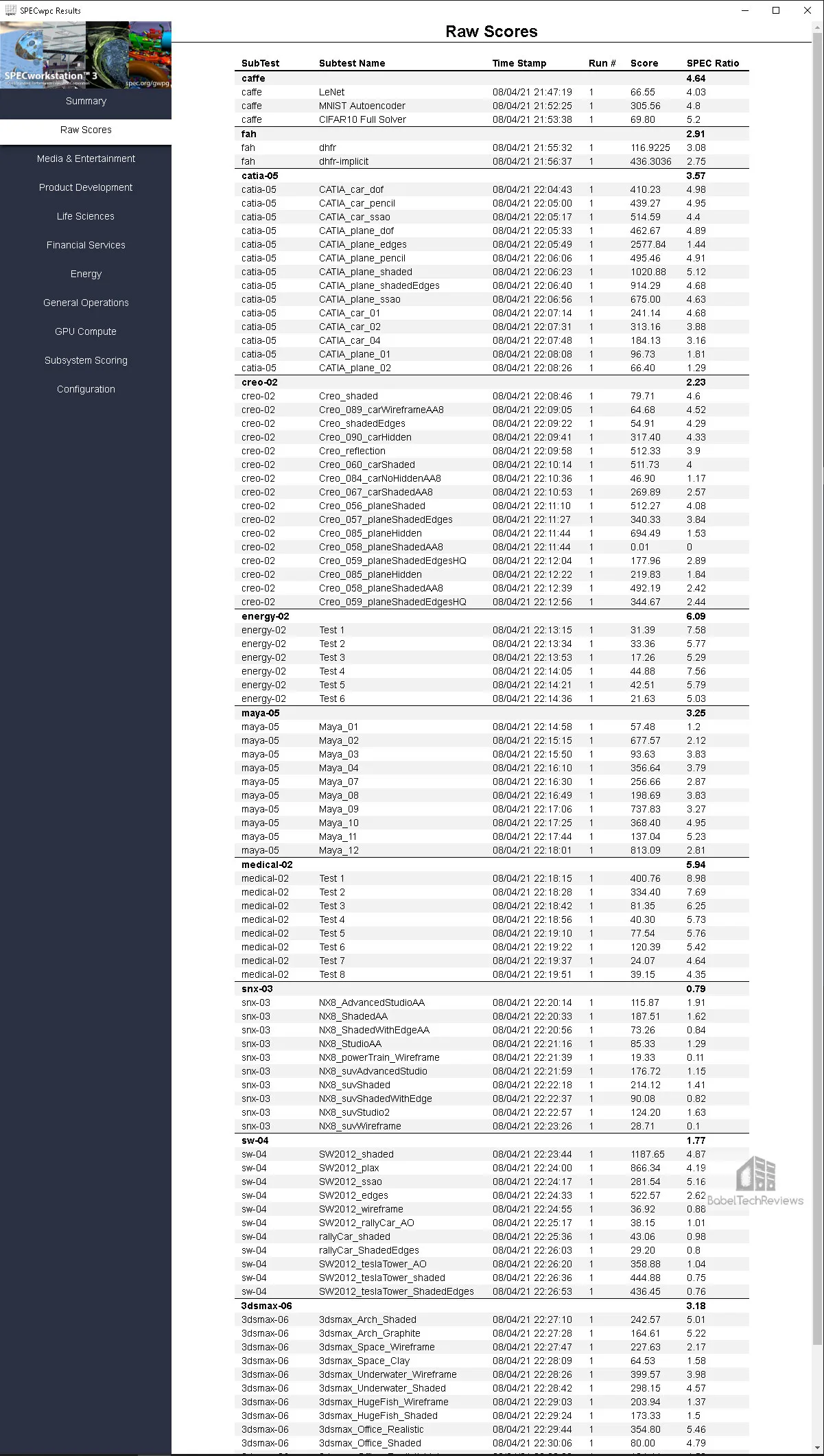

Here are the Red Devil SPECworkstation3 results summarized and included in a chart of our five competing cards. Higher is better.
Using SPEC benchmarks, since the architectures are different, the cards each exhibit different characteristics with different strengths and weaknesses.
SPECviewperf 2020 GPU Benches
The SPEC Graphics Performance Characterization Group (SPECgpc) has released a 2020 version of its SPECviewperf benchmark last year that features updated viewsets, new models, support for both 2K and 4K display resolutions, and improved set-up and results management. We use 2K display resolution for midrange cards like the RX 6600 XT.
Here are the summary results for the Red Devil RX 6600 XT.
Here are SPECviewperf 2020 GPU Red Devil RX 6600 XT benchmarks summarized in a chart together with four other cards.
Again we see different architectures with different strengths and weaknesses. The Red Devil RX 6600 XT is significantly faster than the RX 5600 XT.
After seeing these benches, some creative users may upgrade their existing systems with a new card based on the performance increases and the associated increases in productivity that they require. The question to buy a new video card should be based on the workflow and requirements of each user as well as their budget. Time is money depending on how these apps are used. However, the target demographic for the Red Devil RX 6600 XT is primarily 1080P gaming for gamers.
Let’s head to our conclusion.
Final Thoughts
The Red Devil RX 6600 XT improves significantly over the RX 5600 XT and it trades blows with and overall it beats the RTX 3060 in multiple rasterized games. The Red Devil RX 6600 XT beats the last generation cards including the RX 5600 XT although it struggles with ray traced games compared with GeForce cards. We somewhat handicapped the RX 6600 XT by not being able to use Infinity Cache & Smart Access Memory and we expect that performance would be higher if we used a Ryzen 5000 platform.
FSR brings a great value to the RX 6600 XT as an alternative to DLSS, although it cannot quite match it in visual quality. We look forward to further improvements in FSR and hope many more games use it.
For Radeon gamers, the Red Devil RX 6600 XT is a good alternative to the RTX 3060 for the vast majority of modern PC games that use rasterization. However, the RX 6600 XT offers 8GB of GDDR6 to the 12GB of GDDR6 that the RTX 3060 is equipped with. The RTX 3060, although it has 12GB of vRAM, appears to be wasted for that card.
At its suggested price of $379, or $20 less than the RTX 3060 Ti, the reference RX 6600 XT offers much less value – if the GeForce can be found at all at SEP. PowerColor has promised that the supply of the RX 6600 XT will be plentiful, but we are skeptical. This same thing has been promised for Ampere cards where the stock is still trickling in and being purchased the instant it’s available from etailers that are not hesitating to mark the prices up to double the SEP.
We think that AMD has set pricing too high on the RX 6600 XT by about $50. If it sold for $329 like the RTX 3060, it would be a really good value. They seem to forget that the competing GeForce is much stronger in ray traced games – with over 60 games featuring DLSS – and that FSR is brand new with only a dozen games supporting it so far. At $100 more than what the RX 5600 XT launched at, AMD has jacked up the price of 1080P gaming – pandemic shortages or no shortages – and it is not a consumer friendly move. However, for practical terms – if the RX 6600 XT can be found at MSRP/SEP – it is a good value for now as most other competing cards are still selling for double MSRP.
PowerColor hasn’t set any pricing on the Red Devil RX 6600 XT allowing the resellers to set theirs. They claim that their margins are actually below their usual historical low double-digit (10-12%) for a new product. Unfortunately, it’s hard to recommend any card with no suggested price even though it is overclocked, very nicely equipped, and well-built over a well-designed reference version for $379. We wish that we could say that “PowerColor thinks their Red Devil is worth $30 more than the reference version” – and we would agree. But now there is no pricing frame of reference.
We recommend the Red Devil RX 6600 XT as a great choice out of multiple good choices, especially if you are looking for good looks with RGB, an exceptional cooler, and great performance for 1920×1080, PowerColor’s excellent support, and overall good value assuming that the stock and price stabilizes. We are convinced that PowerColor is an outstanding AMD AIB, and we never hesitate to recommend it to our friends. When we have a choice, we pick and have picked PowerColor video cards for our own purchases.
Let’s sum it up:
The Red Devil RX 6600 XT Pros
- The PowerColor Red Devil RX 6600 XT is much faster than the last generation RX 5600 XT by virtue of new RDNA 2 architecture. It beats the RTX 3060 in many raster games and is a great ultra 1080P card that can handle 1440P with lower settings.
- FSR is an awesome added value that can greatly improves performance without impacting visuals significantly.
- The Red Devil RX 6600 XT has excellent cooling and it is a very quiet card even when overclocked to its maximum
- The Red Devil has a very good power delivery system and dual-fan custom cooling design
- Dual-BIOS give the user a choice of quiet with less overclocking, or a bit louder with more power-unlimited and higher overclocks. It’s also a great safety feature if a BIOS flash goes bad
- FreeSync2 HDR eliminates tearing and stuttering
- Infinity Cache & Smart Access Memory give higher performance with Ryzen 5000 platform
- Customizable RGB lighting and a neutral color allow the Red Devil to fit into any color scheme using the DevilZone software program.
Red Devil RX 6600 XT Cons
- Pricing. $379 for a midrange 1080P card is $100 more than AMD’s RX 5600 XT. And PowerColor has set no SEP
- Weaker ray tracing performance than the RTX 3060
If they can be found at suggested pricing, the Red Devil RX 6600 XT is a good card choice for those who game at 1920×1080, and it represents a good alternative to the RTX 3060 albeit with weaker ray tracing performance. They are offered especially for those who prefer AMD cards and FreeSync2 enabled displays which are generally less expensive than Gsync displays; and Infinity Cache & Smart Access Memory are a real plus for gamers using the Ryzen 5000 platform.
If a gamer is looking for something extra beyond the reference version, the Red Devil RX 6600 XT is a very well made and handsome RGB customizable card that will overclock decently and last a long time without performance degradation.
 The Verdict:
The Verdict:
- PowerColor’s Red Devil RX 6600 XT is a solidly-built good-looking RGB card with higher clocks out of the box than the reference version and it overclocks decently. It trades blows with and overall beats the RTX 3060 in many rasterized games. Although we have no price, it is a kick-ass RX 6600 XT. Hopefully there will be some solid supply and the market pricing will normalize after the cryptocurrency pandemic ends (relatively soon!).
The Red Devil RX 6600 XT offers a good alternative to the RTX 3060 for solid raster performance in gaming, and it also beats the performance of AMD’s last generation by a good margin. However, everything will depend on pricing and availability.
This is what PowerColor boldly stated to us last week:
Good advice! We hope there is good availability, and if so, we can recommend the Red Devil RX 6600 XT even if it is sold even at AMD’s inflated SEP pricing because the competing cards are mostly unavailable for even double their MSRP. Do not reward scalpers or etailers who sell at inflated prices and who do not deserve our business. We can outwait them.
Stay tuned, there is much more coming from BTR. This weekend we will return to VR with a performance evaluation comparing the Red Devil RX 6600 XT with the RTX 3060. And stay tuned for Rodrigo’s upcoming 471.68 driver performance analysis!
Happy Gaming!


